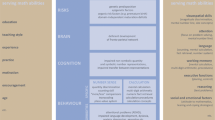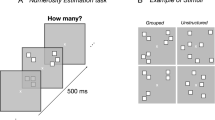Abstract
Neuropsychological studies of dyscalculic patients show that arithmetical development is not a unidimensional process. In transcultural investigations, cultural, educational and linguistic factors might affect differently the various components of mathematical development. Four hundred and sixty schoolchildren aged 7 to 10 years from Brasilia, Brazil (n=141), Paris, France (n=160) and Zurich, Switzerland (n=159) were asked to perform eleven number processing and calculation tasks. Chronological age, which was almost confounded in this study to educational level, had a strong effect on some tasks (knowledge of the written code of numbers, number comparison, mental calculation, problem solving), but only a slight effect on other tasks (counting dots, counting backwards, estimation). Also, linguistic factors and factors related to the socio-economic level of the family had different effects on the various components of calculation and number processing. Evidence from developmental studies has to be integrated into theoretical models of calculation and number processing, which are presently based mainly on results from neuropsychological studies of dyscalculic patients.
Similar content being viewed by others
References
Carraher TN, Carraher DW, Schliemann AD (1985) Mathematics in the streets and in the schools. British Journal of Developmental Psychology 3: 21–29
Dehaene S, Cohen L (1991) Two mental calculation systems: a case study of severe acalculia with preserved approximation. Neuropsychologia 29: 1045–1074
Dehaene S (1992) Varieties of numerical abilities. Cognition 44: 1–42
Dellatolas G, Deloche G, Basso A, Claros-Salinas D (2000) Assessment of calculation and number processing using the EC301 battery: cross-cultural normative data and application to left- and right-brain damaged patients. Journal of the International Neuropsychological Society (submitted)
Deloche G, Seron X, Larroque C, Magnien C, Metz-Lutz MN, Noel MN, Riva I, Schils JP, Dordain M, Ferrand I, Baeta E, Basso A, Claros Salinas D, Gaillard F, Goldenberg G, Howard D, Mazzucchi A, Tzavaras A, Vendrell J, Bergego C, Pradat-Diehl P (1994) Calculation and number processing: assessment battery: role of demographic factors. Journal of Clinical and Experimental Neuropsychology 16: 195–208
Deloche G, von Aster M, Dellatolas G, Gaillard F, Tieche C, Azema D (1995) Traitement des nombres et calcul en CE1 et CE2: quelques données et principes d’élaboration d’une batterie. Approches Neuropsychologiques des apprentissages chez l’enfant Hors série: 42–51
Deloche G, Souza L, Willadino-Braga L, Dellatolas G (1999) Assessment of calculation and number processing by adults: cognitive and neuropsychological issues. Perceptual and Motor Skills 89: 707–738
Deloche G, Souza L, Willadino-Braga L, Dellatolas G (1999) A calculation and number processing battery for clinical application in illiterates and semi-literates. Cortex 35: 503–521
Dowker A (1998) Individual differences in normal arithmetical development. In: Donlan C (ed) The Development of Mathematical Skills (pp 275–302). Hove: Psychology Press
Fuson KC, Richards J, Briars DJ (1982) The acquisition and elaboration of the number word sequence. In: Brainerd CJ (ed) Children’s Logical and Mathematical Cognition: Progress in Cognitive Developmental Research (pp 33–92). New-York: Springer-Verlag
Fuson KC (1992) Research on teaching and learning addition and subtraction of whole numbers. In: Leinhardt G, Putman R, Hattrup RA (eds) Analysis of Arithmetic for Mathematics Teaching. Hillsdale, NJ: Erlbaum
Geary DC, Widaman KF (1987) Individual differences in cognitive arithmetic. Journal of Experimental Psychology: General 116: 154–171
Geary DC (1994) Children’s Mathematical Development. Washington DC: American Psychological Association
Geary DC (1995) Reflections of evolution and culture in children’s cognition: implications for mathematical development and instruction. American Psychologist 50: 24–37
Gelman R, Gallistel CR (1978) The Child’s Understanding of Number. Cambridge, Mass: Harvard University Press
Jordan NC, Huttenlocher J, Levine SC (1994) Assessing early arithmetic abilities: effects of verbal and non verbal response types on the calculation performance of middle- and low-income children. Learning and Individual Differences 6: 413–432
Mandler G, Shebo BJ (1982) Subitizing: an analysis of its component processes. Journal of Experimental Psychology: General 11: 1–22
Miller KF, Stigler JW (1987) Counting in Taiwanese: cultural variation in a basic cognitive skill. Cognitive Development 2: 279–305
Miura IT, Okamoto Y, Kim CC, Chang CM, Steere M, Fayol M (1994) Comparisons of children’s cognitive representation of number: China, France, Japan, Korea, Sweden, and the United States. International Journal of Behavioral Development 17: 401–411
Nairne JS, Healy AE (1983) Counting backwards produces systematic errors. Journal of Experimental Psychology: General 112: 37–40
Nunes T, Schliemann AD, Carraher DW (1993) Street Mathematics and School Mathematics. Cambridge: Cambridge University Press
Perry M, Van der Stoep SW, Yu SL (1993) Asking questions in first grade mathematics classes: potential influence on mathematical thought. Journal of Educational Psychology 85: 31–40
Shalev RS, Manor O, Amir N, Gross-Tsur V (1993) The acquisition of arithmetic in normal children: assessment by a cognitive model of acalculia. Developmental Medicine Child Neurology 35: 593–601
Stein E (1999) Development of mathematical competences. In: Weinert FE & Schneider W (eds) Individual Development from 3 to 12: Findings from the Munich Longitudinal Study. New York: Cambridge University Press
Stevenson HW, Lee S, Chen C, Stigler JW, Hsu C, Kitamura S (1990) Contexts of achievement. Monographs of the Society for Research in Child Development 55
Stevenson HW, Chen C, Lee S (1993) Mathematics achievement of Taiwanese, Japanese, and American children: ten years later. Science 259: 53–58
Towse JN, Saxton M (1997) Linguistic influences on children’s number concept: methodological and theoretical considerations. Journal of Experimental Child Psychology 66: 362–375
Towse JN, Saxton M (1998) Mathematics across national boundaries: cultural and linguistic perspectives on numerical competence. In: Donlan C (ed) The Development of Mathematical Skills (pp 129–150). Hove: Psychology Press
von Aster M (1994) Developmental dyscalculia in children: review of the literature and clinical validation. Acta Paedopsychiatrica 56: 169–178
von Aster M, Deloche G, Dellatolas G, Meier M (1997) Number processing and calculation in 2nd and 3rd grade school children: a comparative study of French-speaking and German-speaking children. Zeitschrift für Entwicklungspsychologie und Pädagogische Psychologie 24: 151–166
Author information
Authors and Affiliations
Corresponding author
Rights and permissions
About this article
Cite this article
Dellatolas, G., von Aster, M., Willadino-Braga, L. et al. Number processing and mental calculation in school children aged 7 to 10 years: a transcultural comparison. European Child & Adolescent Psychiatry 9 (Suppl 2), S102–S110 (2000). https://doi.org/10.1007/s007870070003
Issue Date:
DOI: https://doi.org/10.1007/s007870070003




